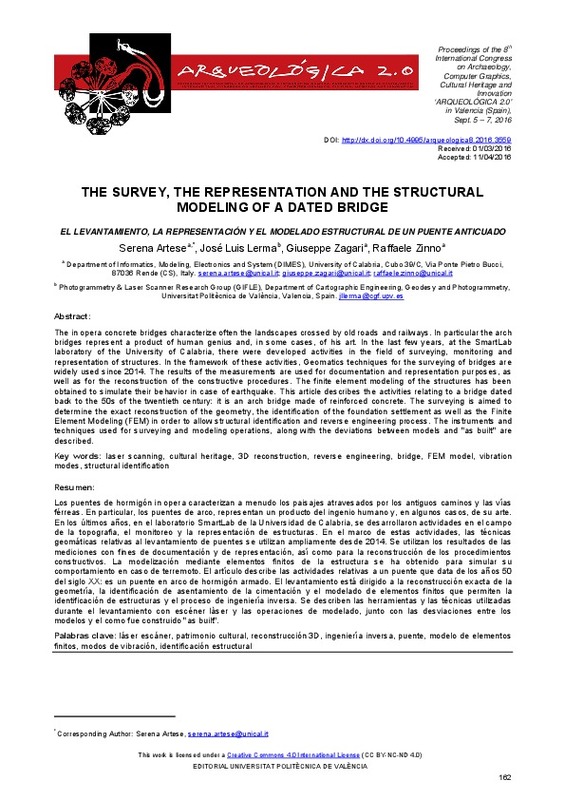JavaScript is disabled for your browser. Some features of this site may not work without it.
Buscar en RiuNet
Listar
Mi cuenta
Estadísticas
Ayuda RiuNet
Admin. UPV
THE SURVEY, THE REPRESENTATION AND THE STRUCTURAL MODELING OF A DATED BRIDGE
Mostrar el registro sencillo del ítem
Ficheros en el ítem
| dc.contributor.author | Artese, Serena
|
es_ES |
| dc.contributor.author | Lerma García, José Luis
|
es_ES |
| dc.contributor.author | Zagari, Giuseppe
|
es_ES |
| dc.contributor.author | Zinno, Raffaele
|
es_ES |
| dc.date.accessioned | 2018-02-05T09:53:15Z | |
| dc.date.available | 2018-02-05T09:53:15Z | |
| dc.date.issued | 2016-10-27 | |
| dc.identifier.isbn | 9788490484555 | |
| dc.identifier.uri | http://hdl.handle.net/10251/96562 | |
| dc.description.abstract | [EN] The in opera concrete bridges characterize often the landscapes crossed by old roads and railways. In particular the arch bridges represent a product of human genius and, in some cases, of his art. In the last few years, at the SmartLab laboratory of the University of Calabria, there were developed activities in the field of surveying, monitoring and representation of structures. In the framework of these activities, Geomatics techniques for the surveying of bridges are widely used since 2014. The results of the measurements are used for documentation and representation purposes, as well as for the reconstruction of the constructive procedures. The finite element modeling of the structures has been obtained to simulate their behavior in case of earthquake. This article describes the activities relating to a bridge dated back to the 50s of the twentieth century: it is an arch bridge made of reinforced concrete. The surveying is aimed to determine the exact reconstruction of the geometry, the identification of the foundation settlement as well as the Finite Element Modeling (FEM) in order to allow structural identification and reverse engineering process. The instruments and techniques used for surveying and modeling operations, along with the deviations between models and "as built" are described. | es_ES |
| dc.description.abstract | [ES] Los puentes de hormigón in opera caracterizan a menudo los paisajes atravesados por los antiguos caminos y las vías férreas. En particular, los puentes de arco, representan un producto del ingenio humano y, en algunos casos, de su arte. En los últimos años, en el laboratorio SmartLab de la Universidad de Calabria, se desarrollaron actividades en el campo de la topografia, el monitoreo y la representación de estructuras. En el marco de estas actividades, las técnicas geomáticas relativas al levantamiento de puentes se utilizan ampliamente desde 2014. Se utilizan los resultados de las mediciones con fines de documentación y de representación, así como para la reconstrucción de los procedimientos constructivos. La modelización mediante elementos finitos de la estructura se ha obtenido para simular su comportamiento en caso de terremoto. El artículo describe las actividades relativas a un puente que data de los años 50 del siglo XX: es un puente en arco de hormigón armado. El levantamiento está dirigido a la reconstrucción exacta de la geometría, la identificación de asentamiento de la cimentación y el modelado de elementos finitos que permiten la identificación de estructuras y el proceso de ingeniería inversa. Se describen las herramientas y las técnicas utilizadas durante el levantamiento con escéner làser y las operaciones de modelado, junto con las desviaciones entre los modelos y el como fue construido "as built" | es_ES |
| dc.format.extent | 7 | es_ES |
| dc.language | Inglés | es_ES |
| dc.publisher | Editorial Universitat Politècnica de València | es_ES |
| dc.relation.ispartof | 8th International congress on archaeology, computer graphics, cultural heritage and innovation | es_ES |
| dc.rights | Reconocimiento - No comercial - Sin obra derivada (by-nc-nd) | es_ES |
| dc.subject | Laser scanning | es_ES |
| dc.subject | Cultural heritage | es_ES |
| dc.subject | 3D reconstruction | es_ES |
| dc.subject | Reverse engineering | es_ES |
| dc.subject | Bridge | es_ES |
| dc.subject | FEM model | es_ES |
| dc.subject | Vibrations modes | es_ES |
| dc.subject | Structural identification | es_ES |
| dc.title | THE SURVEY, THE REPRESENTATION AND THE STRUCTURAL MODELING OF A DATED BRIDGE | es_ES |
| dc.title.alternative | EL LEVANTAMIENTO, LA REPRESENTACIÓN Y EL MODELADO ESTRUCTURAL DE UN PUENTE ANTICUADO | es_ES |
| dc.type | Capítulo de libro | es_ES |
| dc.type | Comunicación en congreso | es_ES |
| dc.identifier.doi | 10.4995/arqueologica8.2016.3559 | |
| dc.rights.accessRights | Abierto | es_ES |
| dc.contributor.affiliation | Universitat Politècnica de València. Departamento de Ingeniería Cartográfica Geodesia y Fotogrametría - Departament d'Enginyeria Cartogràfica, Geodèsia i Fotogrametria | es_ES |
| dc.contributor.affiliation | Universitat Politècnica de València. Escuela Técnica Superior de Ingeniería Geodésica, Cartográfica y Topográfica - Escola Tècnica Superior d'Enginyeria Geodèsica, Cartogràfica i Topogràfica | es_ES |
| dc.description.bibliographicCitation | Artese, S.; Lerma García, JL.; Zagari, G.; Zinno, R. (2016). THE SURVEY, THE REPRESENTATION AND THE STRUCTURAL MODELING OF A DATED BRIDGE. En 8th International congress on archaeology, computer graphics, cultural heritage and innovation. Editorial Universitat Politècnica de València. 162-168. https://doi.org/10.4995/arqueologica8.2016.3559 | es_ES |
| dc.description.accrualMethod | OCS | es_ES |
| dc.relation.conferencename | ARQUEOLÓGICA 2.0 - 8th International Congress on Archaeology, Computer Graphics, Cultural Heritage and Innovation | es_ES |
| dc.relation.conferencedate | September 05-07,2016 | es_ES |
| dc.relation.conferenceplace | Valencia, Spain | es_ES |
| dc.relation.publisherversion | http://ocs.editorial.upv.es/index.php/arqueologica20/arqueologica8/paper/view/3559 | es_ES |
| dc.description.upvformatpinicio | 162 | es_ES |
| dc.description.upvformatpfin | 168 | es_ES |
| dc.type.version | info:eu-repo/semantics/publishedVersion | es_ES |
| dc.relation.pasarela | OCS\3559 | es_ES |








